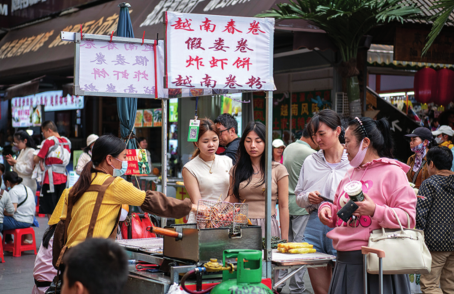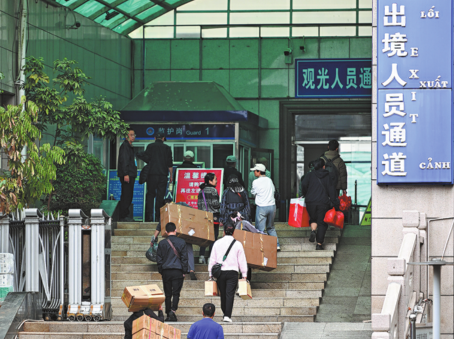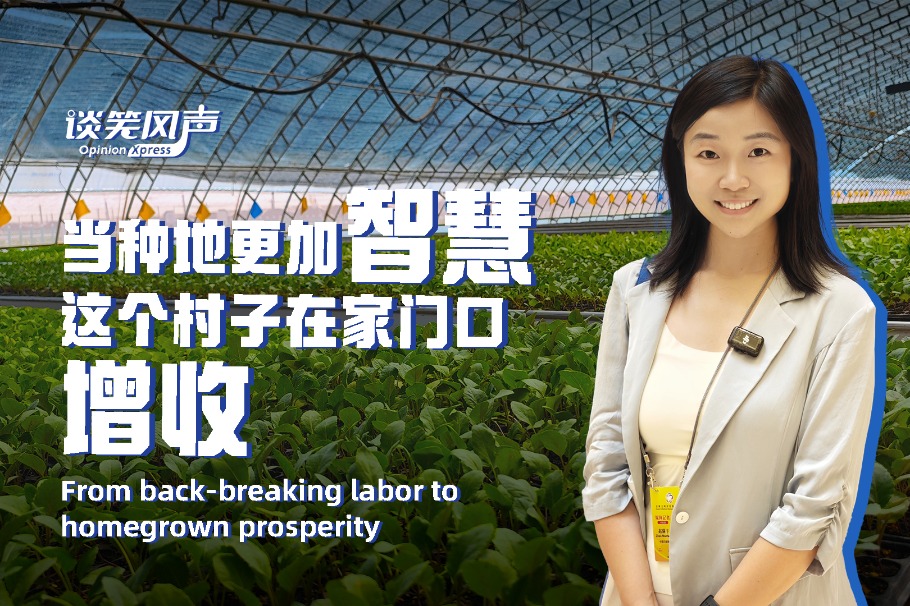Transnational road freight opens up opportunities
Cross-border agreement allows Chinese, Vietnamese trucks to operate in both countries for first time

Freight vehicles from either side of the China-Vietnam border were allowed to cross for the first time on May 14, enabling drivers from both sides to deliver deeper and more efficiently into both countries. Previously, all freight goods needing to cross the China-Vietnam border by road had to be unloaded and reloaded onto trucks operating on the other side.
The milestone in cross-border connectivity is due to years of negotiation and organization by the Greater Mekong Subregion development program, resulting in the Cross-Border Transport Facilitation Agreement (CBTA).
The agreement, initially proposed in 1999, aims to streamline the movement of people and goods across six countries: China, Vietnam, Laos, Cambodia, Thailand and Myanmar, boosting regional connectivity.
The first trial run of the cross-border transport facilitation agreement took place last year involving China, Cambodia, Laos and Thailand.
It's estimated that the loosening of borders for goods transport in the Greater Mekong Subregion, for China, in Yunnan province and the Guangxi Zhuang autonomous region specifically, will bring huge economic benefits.
Last year, bilateral trade between China and Vietnam surpassed $260 billion, with China maintaining its position as Vietnam's largest trade partner for the 20th consecutive year.
Efficient delivery
Despite driving goods trucks between China and Vietnam for many years, Li Cishen had never ventured further than the border city of Lao Cai on the Vietnam side, but on May 14 he was among a convoy of Chinese truck drivers who departed from Kunming, capital of Yunnan province, to pass directly into Vietnam to deliver their goods.
Instead of stopping at the border and unloading his truck, a task that takes time and costs approximately 800 to 1,000 yuan ($112 to 140), Li drove his 18-meter vehicle straight on to Hanoi, the Vietnamese capital, to deliver a load of fresh vegetables.
The 700-kilometer international journey was an eye-opener for the experienced driver.
"Before this, I only made it to Lao Cai and called that Vietnam," Li said. "This time, I went all the way to Hanoi. That's a first for me."
Li was joined by 17 other Chinese drivers who set off from Kunming, and Nanning in Guangxi, heading south to Vietnam. Their freight vehicles, carrying electronics, fresh produce, flowers, general merchandise and two passenger buses, arrived in Hanoi the following day.
Jin Jia, director of international business at Chinese logistics company, Yunnan Maosheng International Logistics, said his company is set to directly benefit from the new agreement.
"Now our trucks can drive directly into Vietnam's major cities like Hanoi and Ho Chi Minh City without having to transship goods at the border," Jin said.
"This permit works like a passport for our trucks — domestically, we use the vehicle license, and internationally we use the GMS permit," he said.
Currently, the agreement allows for 500 permits for goods vehicles from each side crossing the border.
Pu Xiaoqiang, general manager at Yunnan Youjie International Logistics, another Chinese firm, said the increased efficiency will boost business on both sides of the border.
"For perishable goods like vegetables and flowers, this time saving is critical," Pu said. "Earlier, it took two days to reach Hanoi from Kunming. Now it takes just one. In Vietnam's hot climate, speed determines freshness."
Vietnamese consumers have a growing appetite for flowers and fresh vegetables from Kunming, while Chinese buyers favor tropical fruits like durian and lychees from Vietnam. "These agricultural products are extremely sensitive to time and temperature," Pu said. "With no need for reloading or unloading, cargo damage is nearly zero."
Making a milestone
Yuya Yamamoto, a trade specialist from the Asian Development Bank, said that the cross-border agreement was a milestone, and that goods can now be transported by certified vehicles across five countries.
Ron Slangen, deputy country director for Vietnam at the ADB, emphasized Vietnam's strategic location — bordering China, Laos and Cambodia — as a vital transport hub for the Greater Mekong Subregion.
"The successful implementation of the GMS CBTA represents more than just trucks crossing borders — it symbolizes the breaking down of barriers that can unlock the region's full potential. As GMS corridors come to life and supply chains strengthen, we are laying the foundation for unprecedented economic prosperity," Slangen said.
He said Vietnam plays a critical role in regional supply chains, making cross-border initiatives crucial for advancing trade and connectivity.
Chinese and Vietnamese officials have echoed this optimism, highlighting both the immediate benefits and long-term potential.
"The launch of international road transport between China and Vietnam is an important milestone in deepening practical cooperation between the two countries, and another achievement of the Belt and Road Initiative," said Liu Peng, director of the Global Sustainable Transport Innovation and Knowledge Center, part of China's Ministry of Transport.
Wang Xiuchun, deputy director of the transport services department at the ministry, said increased integration among Greater Mekong Subregion countries benefits all.
"It reflects China's strong support for connectivity among Greater Mekong Subregion countries and offers an effective path for cross-border economic cooperation in the Lancang-Mekong region, promoting integration, prosperity, sustainability and inclusiveness," Wang said.
Zhang Jie, also a deputy director at the transport services department, added, "The new routes not only reduce transport time and distance, but also strengthen the link between China's Western Land-Sea Trade Corridor and Vietnam's 'Two Corridors, One Economic Circle' strategy — accelerating industrial cooperation and fostering deeper economic integration."
On the Vietnamese side, authorities are also upbeat about the corridor's impact.
Bui Quang Thai, director of Vietnam's Road Administration, said: "The Vietnam-China GMS transport network comprises two main corridors — Kunming-Hanoi-Hai Phong and Nanning-Hanoi. These are critical road transport arteries with high trade volumes and play a vital role in bilateral trade between the two countries."
He said that direct cross-border movement into the interior of both countries will not only enhance trade but also promote tourism, economic cooperation and people-to-people exchanges.
"The operation of these two routes under the GMS framework will bring tangible benefits: enhancing connectivity, reducing time and costs for businesses, simplifying procedures and promoting trade, logistics, investment, and regional economic growth," he said, adding that it's a major step toward realizing a deeply connected, integrated and sustainably developed GMS.
Do Quoc Phong, deputy head of the Transport Management Department at Vietnam's Road Administration, said, "This launch is not just a technical achievement — it's a vivid symbol of the practical and effective cooperation between our two nations."
One journey, two tongues
Despite his 20 years of driving experience, truck driver Li faced a new challenge on his first trip across the border into Vietnam. "My phone had no reception and the navigation system failed," he said. "I couldn't connect online, which made me feel blind."
Help came from Nguyen Quy Hoi, a Vietnamese logistics partner assigned to accompany him from Lao Cai to Hanoi. Though the two shared no common language, they forged a partnership through technology and trust. Using a translation app, Nguyen sat in the cab beside Li for the entire journey, assisting with customs paperwork, directions and even mealtime communication.
Despite the success of the journey, the road wasn't without bumps.
"Before departure, our company installed a new navigation system in my truck — but it didn't work once we got into Vietnam," said Li.
"Even my mobile phone, with an international plan, couldn't connect. I didn't realize the issue until I was already on the highway in Vietnam."
Yamamoto, from the Asian Development Bank, acknowledged the need for more operational experience.
"As the CBTA has only recently become active, it's crucial for more operators from participating countries to join and gain firsthand experience," he said. "This will help us fine-tune the process and ensure smooth implementation across the region."
On the Vietnamese side, logistics companies are eager to participate — but need better access to information.
"Most Vietnamese companies still don't know how to apply for GMS permits," said Ha Tien Dat, head of Vietnam-based Datani Logistics Co. "We hope more guidance will be provided."
Ha, who obtained practical knowledge through his Chinese partners, now assists Chinese logistics firms with customs declarations and other cross-border procedures.
"We want to send Vietnamese trucks deep into China, too," he added.
Road ahead
While technical and procedural hurdles remain, the outlook is optimistic.
Drivers like Li are undeterred. He said he planned to fix his connectivity issues as soon as he returns to China — and is already looking forward to his next trip.
"In the short term, we aim to make full use of the framework, allowing each country to issue up to 500 transport permits," Yamamoto said. "In the medium term, the goal is to expand the agreement to cover more countries and routes."
With the first round of journeys now complete and all Chinese trucks safely back home, logistics companies are reflecting and preparing.
Pu, general manager at Yunnan Youjie International Logistics, said daily flower shipments to Vietnam will start from June 1. Gong Rui, chairman of Yunnan Yunjie Technology, is also gearing up for a second cross-border delivery.
Digital efficiency
Digital platforms are also helping to unlock new efficiencies along these international routes.
Gong Rui, chairman of Yunnan Yunjie Technology, said his company supports small and micro logistics firms by matching them with transport providers, thereby reducing costs and improving delivery efficiency.
"Through our platform, we have even helped clients arrange return shipments from Vietnam to avoid empty backhaul trips," Gong said. "Logistics should be borderless. When managed well, it creates real value for businesses and consumers."
His company also joined the recent cross-border run, delivering fabric to a Vietnamese factory.
The sentiment was echoed by Vietnamese logistics partners. Nguyen Van Duc, general manager of Hateco, a Vietnamese conglomerate, said the new transport route has significantly simplified customs procedures and lowered logistics expenses.
"It's a win-win for importers and exporters on both sides," he said.





Today's Top News
- China to open its door to foreign investment wider
- China criticizes Canadian tariffs on products containing Chinese steel
- US legislative chaos undermines its democracy
- Why China is irreplaceable in supply chain
- China's FDI inflow tops $700b since 2021
- Australia, China set to bolster steel partnership






























